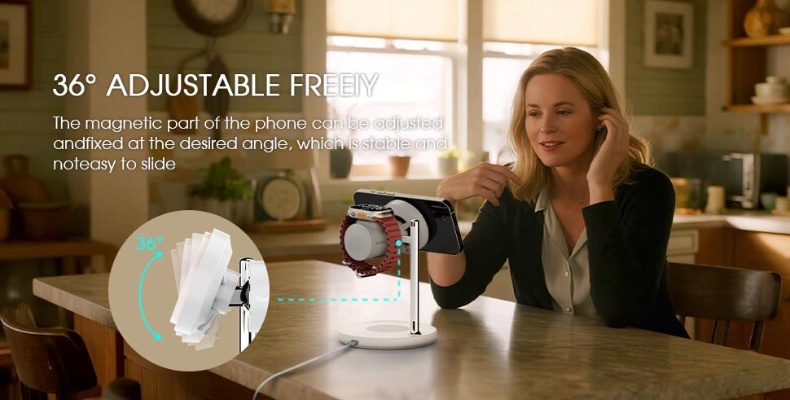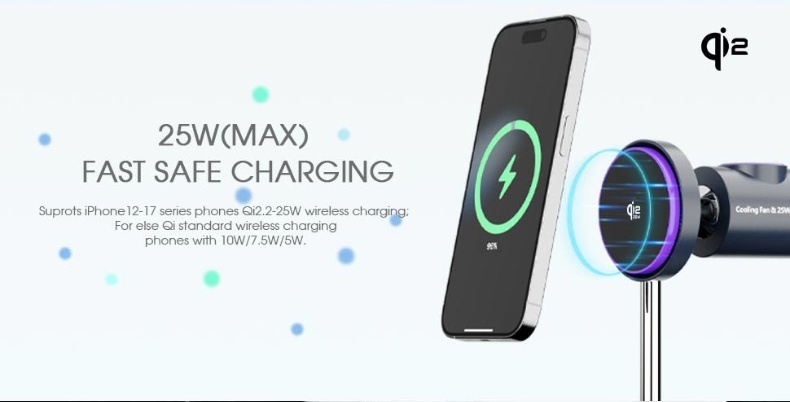As wireless charging technology continues to evolve, particularly with the rise of Qi2.2 fast wireless chargers and magnetic wireless chargers, more consumers are embracing this convenient way to power their smartphones. However, one common concern persists: Can wireless chargers damage battery life?
The short answer is no — wireless chargers do not damage your smartphone’s battery life when used correctly, especially if the charger is Qi-certified, employs intelligent power management, and meets industry safety standards. However, certain conditions, such as excessive heat generation or low-quality, uncertified charging devices, can negatively affect long-term battery health. To understand why, we need to explore how wireless charging works, how batteries age, and what modern intelligent charging systems do to prevent damage.

1. How Wireless Charging Works
Wireless charging operates on the principle of electromagnetic induction, a technology standardized under the Qi and now Qi2 frameworks by the Wireless Power Consortium (WPC). In this process, an electrical current passes through a coil in the charger, creating a magnetic field. A second coil in the smartphone converts that magnetic energy back into electrical current, which charges the device’s battery.
Qi2.2 and magnetic wireless chargers enhance this process through precise magnetic alignment, ensuring optimal coil positioning, reduced energy loss, and improved charging efficiency. These improvements minimize the heat typically associated with earlier generations of wireless chargers — a key factor in protecting battery longevity.
2. The Real Factors That Affect Battery Life
To understand whether wireless charging harms a battery, it’s important to know how lithium-ion batteries degrade over time. All rechargeable smartphone batteries experience gradual capacity loss, typically measured in charge cycles — one complete charge from 0% to 100%. On average, lithium-ion batteries retain about 80% of their original capacity after 500 to 800 cycles.
Battery wear primarily depends on:
Heat exposure: High temperatures accelerate chemical degradation inside the battery.
Overcharging or deep discharging: Though rare in modern devices, poor voltage regulation can cause stress.
High charge currents: Fast charging increases heat, which, if unmanaged, can shorten battery lifespan.
It’s not the charging method itself (wired or wireless) that damages the battery — it’s the thermal and electrical stress caused by inefficient or poorly controlled power delivery. Certified wireless chargers are specifically designed to manage these factors intelligently.
3. Modern Wireless Chargers Are Designed for Battery Protection
High-quality wireless chargers, particularly those built to Qi 1.3 and Qi2.2 standards, integrate multiple layers of protection and intelligent power management systems that directly safeguard battery health.
Key protective features include:
- Dynamic power adjustment: The charger communicates with the smartphone to deliver the precise amount of current needed at each charging stage.
- Temperature control sensors: These continuously monitor surface and internal temperatures, slowing charging if heat rises beyond safe limits.
- Foreign object detection (FOD): Automatically halts charging if metal objects (like coins or keys) interfere with the process.
- Automatic trickle charging: Once the phone reaches full capacity, the charger stops active power transfer, preventing overcharging.
- Advanced MagSafe-compatible and Qi2-certified magnetic chargers go further by ensuring perfect coil alignment through magnetic positioning. This alignment reduces energy loss — and therefore excess heat — by up to 30% compared to earlier wireless charging pads.
4. Heat: The Primary Risk to Battery Longevity
When discussing wireless charging and battery health, heat is the central issue. Because wireless charging involves power transfer through electromagnetic fields, it naturally generates more heat than wired charging. Poorly designed chargers, or those without adequate heat dissipation and temperature management, can allow this heat to build up, accelerating battery degradation.
However, modern intelligent wireless chargers mitigate this risk through improved efficiency and active cooling mechanisms. Many Qi2.2 chargers now feature aluminum alloy heat sinks, temperature sensors, and adaptive energy modulation to maintain optimal thermal conditions.
From a technical standpoint, a phone battery’s ideal charging temperature range is between 20°C and 40°C (68°F to 104°F). A high-quality wireless charger will automatically regulate power output to stay within this range, ensuring safe operation and minimal long-term battery impact.
5. Fast Wireless Charging and Battery Safety
Fast wireless charging — which can deliver between 15W and 30W on the latest Qi2.2 systems — raises additional concerns about potential battery wear. However, the technology’s intelligence lies in its ability to dynamically adjust charging speed according to the device’s temperature and battery percentage.
For example, many smartphones charge rapidly only up to about 60–70% capacity, then gradually reduce the current to prevent heat buildup during the final phase. This staged approach, known as “smart charging” or “trickle charging,” minimizes stress on the battery and is equally safe across both wired and wireless charging methods.

6. The Risks of Cheap or Uncertified Chargers
While certified wireless chargers are safe, low-cost, non-certified products pose real risks. These chargers often lack:
- Proper voltage and current regulation
- Temperature sensors or cutoff circuits
- Coil alignment optimization
- Compliance with safety standards (Qi, CE, FCC, RoHS)
Using such devices can result in unstable power delivery, excessive heat, or even battery swelling and reduced lifespan. For this reason, consumers should always look for Qi or Qi2 certification marks and purchase from reputable brands with transparent safety testing.
7. Best Practices for Protecting Battery Life During Wireless Charging
To maximize your battery’s longevity when using a wireless charger, follow these simple professional guidelines:
- Use certified chargers: Always choose Qi or Qi2-certified products from reputable manufacturers.
- Avoid direct sunlight or high temperatures: Do not leave your phone charging in hot environments, such as inside a car.
- Remove thick or metal cases: They can obstruct power transfer and cause additional heat buildup.
- Charge in shorter sessions: Topping up your battery between 30–80% is healthier than full discharges.
- Keep the surface ventilated: Use chargers with open designs or integrated cooling features to allow heat dissipation.
- Following these practices ensures safe, efficient wireless charging with minimal impact on long-term battery performance.
8. The Future of Wireless Charging: Smarter and Cooler
The next generation of wireless charging, led by Qi2.2 magnetic alignment and adaptive power control, promises even better thermal performance and energy efficiency. These advancements, inspired by Apple’s MagSafe system, ensure near-perfect coil alignment and reduce energy loss — meaning faster charging with lower heat output.
Furthermore, AI-enhanced intelligent charging systems are emerging, capable of learning user habits and optimizing charge cycles to further extend battery lifespan. In the near future, wireless charging will not just be safe — it will actively enhance battery management through predictive algorithms and dynamic control.

Conclusion
In conclusion, wireless chargers do not damage smartphone battery life when they are properly designed, certified, and used under normal conditions. The primary enemy of battery health is excess heat, not the wireless charging technology itself. With the advent of Qi2.2 fast wireless charging and magnetic alignment systems, today’s intelligent chargers deliver power more efficiently and safely than ever before.
By choosing certified, high-quality chargers and following basic charging best practices, users can enjoy the full convenience of wireless charging without compromising battery performance. In fact, intelligent wireless charging — with its precise power regulation and heat management — represents the future of safer, smarter, and longer-lasting battery care.
